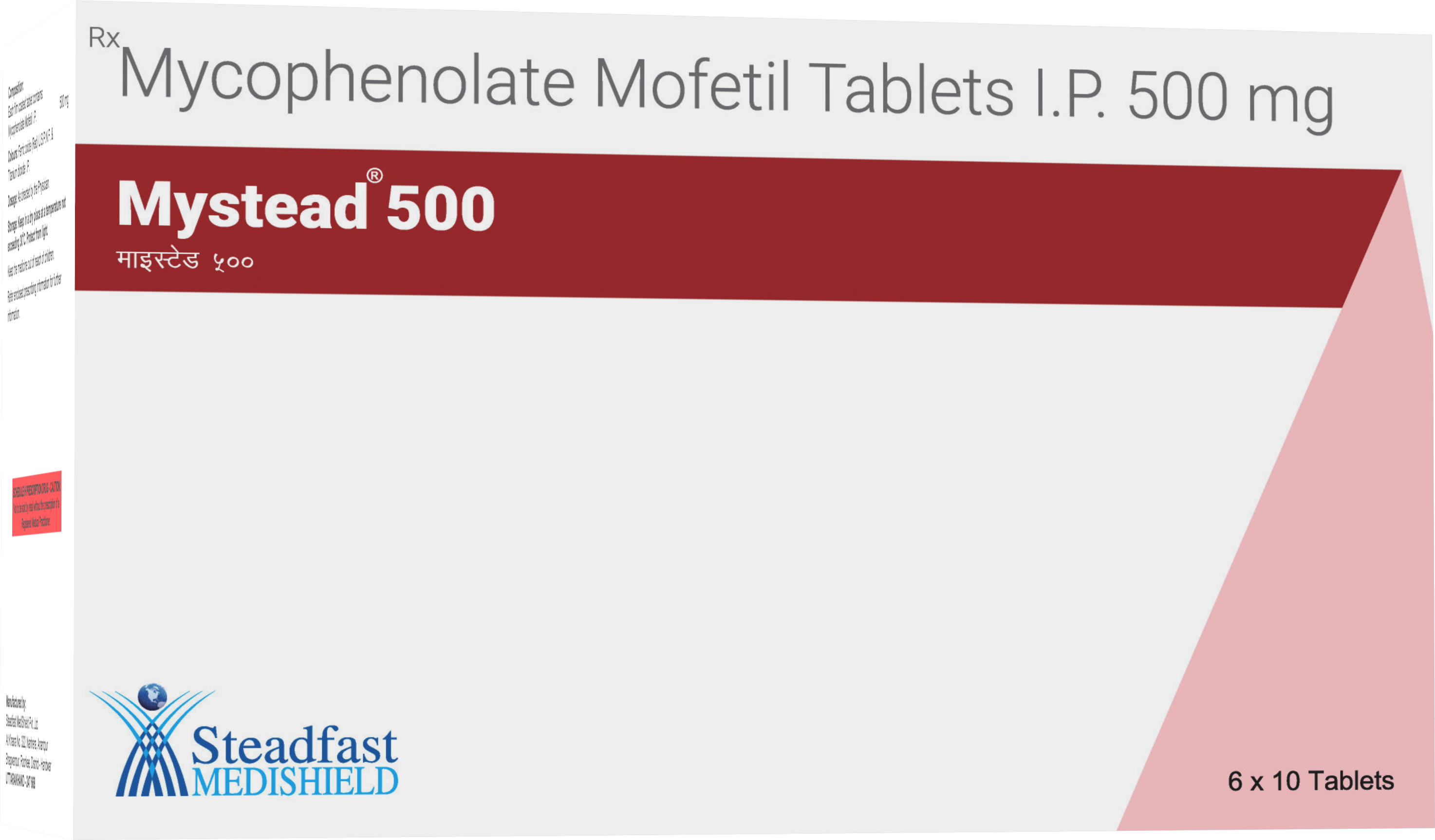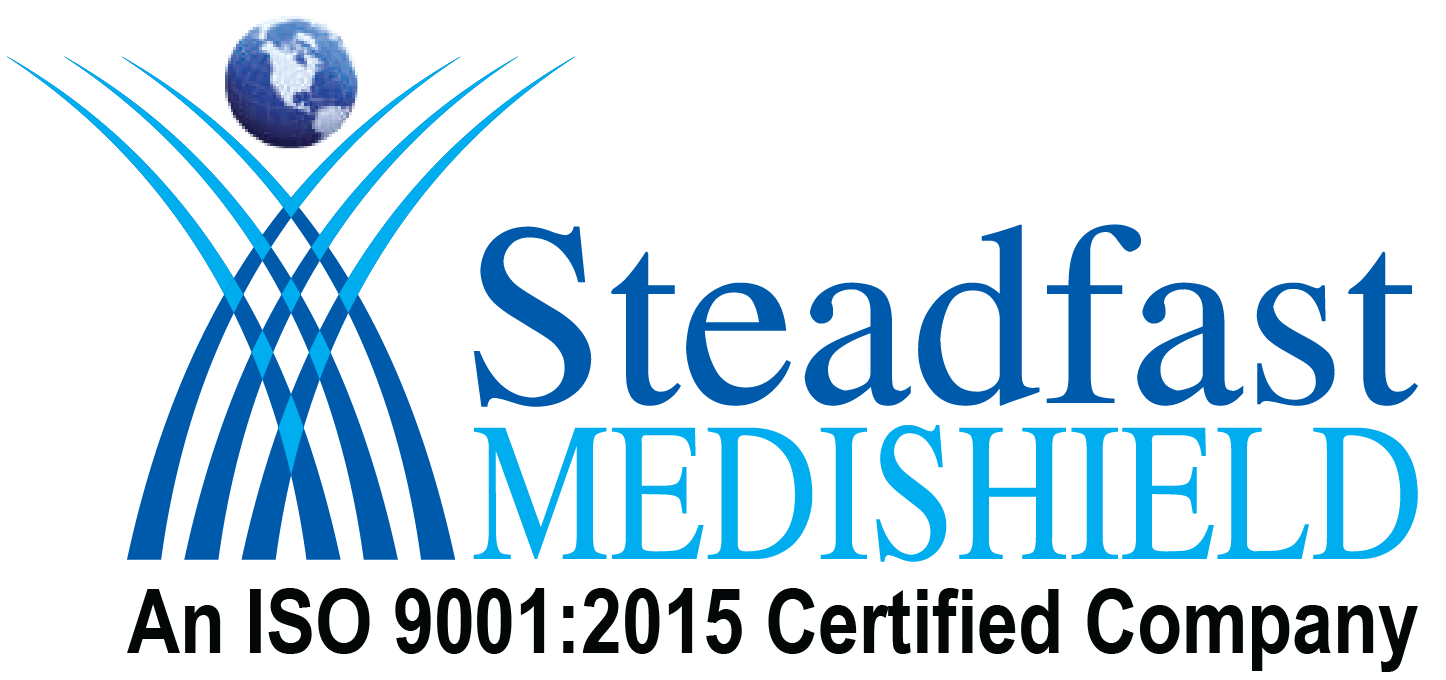
Description:
Mystead is mycophenolate mofetil, which is chemically the 2-morpholinoethyl ester of mycophenolic acid (MPA), an immunosuppressive agent; inosine monophosphate dehydrogenase (IMPDH) inhibitor.
Pharmacology:
Mechanism of action:
Mycophenolate Mofetil is a morpholinoethyl ester prodrug of the immunosuppressant mycophenolic acid (MPA), a fermentation product of several Penicillium species. The mechanism of action of MPA is based on interference with purine synthesis. It is a reversible, noncompetitive inhibitor of inosine monophosphate dehydrogenase (IMPDH) which is an enzyme that facilitates the conversion of inosine monophosphate (IMP) to xanthosine monophosphate, a precursor of guanine nucleotides.This blocks the de novo synthesis of guanosine nucleotides which are necessary substrates for DNA and RNA synthesis. Unlike other cell types which can use the salvage pathways, B and T lymphocytes are dependent upon the de novo pathway for the generation of guanosine.
Pharmacokinetics
Mycophenolate Mofetil is rapidly absorbed after oral administration and converted to the active metabolite, MPA. MPA is then further metabolized to MPA glucuronide (MPAG), which is pharmacologically inactive.
Bioavailability:
The mean relative bioavailability of MPA is 94% for oral administration. The maximum plasma concentration (Cmax) occurs approximately 2 hours after oral administration. Observed secondary peaks in plasma levels are due to the enterohepatic circulation of the drug.
Absorption:
Food has no effect on the extent of absorption (MPA AUC) of Mycophenolate Mofetil when administered at doses of 1.5 g BID to renal transplant patients. However MPA Cmax was lowered by 40% in the presence of food. MPA binds to plasma albumin in a concentration dependent manner. MPA binding is not altered by the common immunosuppressive medications, including cyclosporine, prednisone, and tacrolimus, or other common medications, including warfarin, digoxin, and phenytoin. MPA is minimally bound to plasma lipoproteins in a concentration – independent manner.
Metabolism:
MPA is converted to MPAG and three additional inactive metabolites, N-(2-carboxymethyl)-morpholine, N-(2-hydroxyethyl)-morpholine, and the N-oxide of N-(2-hydroxyethyl)-morpholine. Alcoholic cirrhosis does not appear to appreciably alter the hepatic metabolism of MPA to MPAG.
Excretion:
MPA is eliminated primarily by the kidneys, with more than 90% of the dose excreted in the urine as MPAG.
Drug interactions
Drugs which are eliminated by renal tubular secretion (e.g. aciclovir, ganciclovir) have the potential to inhibit the elimination of MPAG through competition for renal tubular secretion.Agents that interfere with enterohepatic recycling (e.g. bile acid sequestrants, antibiotics) may reduce the amount of mycophenolic acid available for reabsorption. In healthy volunteers concomitant administration of single doses of Mycophenolate Mofetil and aciclovir resulted in a significantly higher AUC of MPAG than when Mycophenolate Mofetil was given alone.Co administration of Mycophenolate Mofetil and cholestyramine resulted in a 40% decrease in the AUC of mycophenolic acid. Administration of a single dose of Mycophenolate Mofetil 2 g to patients with rheumatoid arthritis who were receiving an aluminum hydroxide / magnesium hydroxide antacid resulted in reductions on the AUC24 (33%) and Cmax (17%) of mycophenolic acid compared with administration of Mycophenolate Mofetil alone.Single and/or multiple dose studies have reported no pharmacokinetic interaction between Mycophenolate Mofetil and ganciclovir, cotrimoxazole, oral contraceptives or cyclosporine.
Indications
Allogeneic transplants:
For the prophylaxis of organ rejection in patients receiving allogeneic renal, hepatic or cardiac transplant. Use Mycophenolate concomitantly with cyclosporine and corticosteroids.Dosage and administration
Renal transplantation:
A dose of 1 g administered orally twice a day (daily dose of 2 g). Although a dose of 1.5 g twice daily (daily dose of 3g) was used in clinical trials and was shown to be safe and effective, no efficacy advantage could be established for renal transplant patients. Patients receiving 2 g/day demonstrate an overall better safety profile than patients receiving 3 g/day.
Cardiac transplantation:
A dose of 1.5 g administered orally twice a day (daily dose of 3 g) is recommended.
Hepatic transplantation:
A dose of 1.5 g administered orally twice a day is recommended.Give the initial oral dose as soon as possible following transplant. Food has been shown to decrease MPA Cmax by 40%. It is recommended that Mycophenolate be administered on an empty stomach.
Warnings
Pregnancy:
There are no adequate and well controlled studies in pregnant women. Do not use in pregnant women unless the potential benefit justifies the potential risk to the foetus.
Lactation:
Studies in rats treated with Mycophenolate have shown mycophenolic acid to be excreted in milk. It is not known whether this drug is excreted in human breast milk. Because of the potential for serious adverse reactions in nursing infants from Mycophenolate, decide whether to discontinue nursing or to discontinue the drug, taking into account the importance of the drug to the mother.
Children:
Safety and efficacy have not been established.
Lymphomas / Malignancies:
Patients receiving immunosuppressive regimens involving combinations of drugs, including Mycophenolate, as part of an immunosuppressive regimen are at increased risk of developing lymphomas and other malignancies, particularly of the skin. The risk appears to be related to the intensity and duration of immunosuppression rather than to the use of any specific agent. Oversuppression of the immune system can also increase susceptibility to infection.
Neutropenia:
Monitor patients receiving Mycophenolate for neutropenia. The development of neutropenia may be related to Mycophenolate itself, concomitant medications, viral infections or some combination of these causes.
Renal Function Impairment:
Avoid Mycophenolate doses >1 g twice a day and carefully observe patients.
Precautions
Monitoring:
Perform complete blood counts weekly during first month of treatment, twice monthly for second and third months, then monthly through the first year.
Adverse Effects
Since Mycophenolate has been associated with an increased incidence of GI adverse events, including infrequent cases of GI tract ulceration, hemorrhage, and perforation, administer with caution in patients with active serious GI disease. Delayed renal graft function post transplant: No dose adjustment is recommended for these patients, however they should be carefully observed.
Overdosage
Acute over dosages of up to 30 times the intended dose have been reported. Almost all cases have been asymptomatic and all patients recovered with no sequelae. Occasionally, acute over dosage has been followed by adverse reactions with those listed previously. General supportive measures and treatment of specific symptoms should be followed in all cases of over dosage.
Contraindications
Hypersensitivity to drug, mycophenolic acid, or any component of the drug product.
Presentation
10 tablets packed in a strip, 6 such strips packed in a carton
